Peugeot Partner Tepee 2015 Owner's Manual
Manufacturer: PEUGEOT, Model Year: 2015, Model line: Partner Tepee, Model: Peugeot Partner Tepee 2015Pages: 276, PDF Size: 12.76 MB
Page 161 of 276
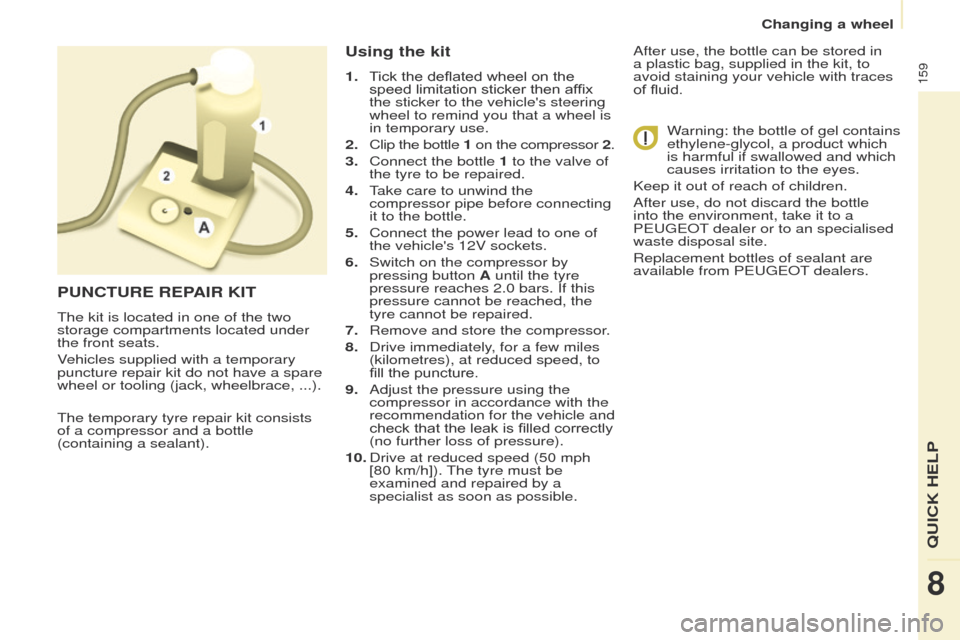
159
Partner_2_VP_en_Chap08_Aide-rapide_ed02-2014
the temporary tyre repair kit consists
of a compressor and a bottle
(containing a sealant).
Using the kit
1. Tick the deflated wheel on the speed limitation sticker then affix
the sticker to the vehicle's steering
wheel to remind you that a wheel is
in temporary use.
2.
Clip the bottle
1 on the compressor
2.
3.
Connect the bottle
1 to the valve of
the tyre to be repaired.
4.
t
ake care to unwind the
compressor pipe before connecting
it to the bottle.
5.
Connect the power lead to one of
the vehicle's 12V sockets.
6.
Switch on the compressor by
pressing button
A until the tyre
pressure reaches 2.0 bars. If this
pressure cannot be reached, the
tyre cannot be repaired.
7.
Remove and store the compressor
.
8.
Drive immediately
, for a few miles
(kilometres), at reduced speed, to
fill the puncture.
9.
Adjust the pressure using the
compressor in accordance with the
recommendation for the vehicle and
check that the leak is filled correctly
(no further loss of pressure).
10.
Drive at reduced speed (50
mph
[80 km/h]).
t
he tyre must be
examined and repaired by a
specialist as soon as possible. After use, the bottle can be stored in
a plastic bag, supplied in the kit, to
avoid staining your vehicle with traces
of fluid.
Warning: the bottle of gel contains
ethylene-glycol, a product which
is harmful if swallowed and which
causes irritation to the eyes.
Keep it out of reach of children.
After use, do not discard the bottle
into the environment, take it to a
P
euge O t
dealer or to an specialised
waste disposal site.
Replacement bottles of sealant are
available from P
euge O t
dealers.
PUNCTURE REPAIR KIT
the kit is located in one of the two
storage compartments located under
the front seats.
V
ehicles supplied with a temporary
puncture repair kit do not have a spare
wheel or tooling (jack, wheelbrace, ...).
Changing a wheel
QuICK HeLP
8
Page 162 of 276
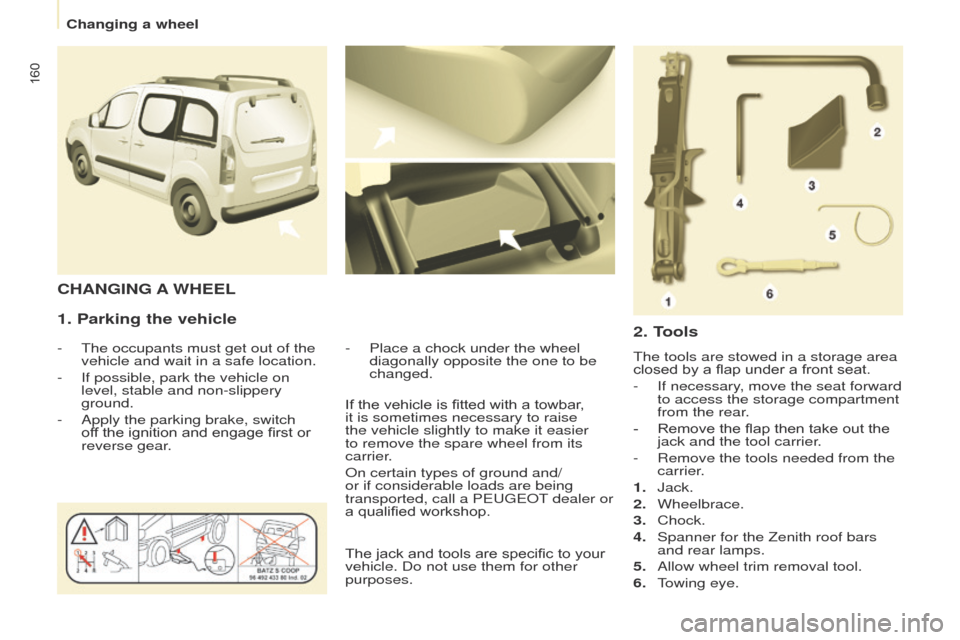
160
Partner_2_VP_en_Chap08_Aide-rapide_ed02-2014
1. Parking the vehicle
- the occupants must get out of the
vehicle and wait in a safe location.
-
If possible, park the vehicle on
level, stable and non-slippery
ground.
-
Apply the parking brake, switch
of
f the ignition and engage first or
reverse gear. -
Place a chock under the wheel
diagonally opposite the one to be
changed.
CHANGING A WHEEL
2. Tools
the tools are stowed in a storage area
closed by a flap under a front seat.
-
If necessary
, move the seat forward
to access the storage compartment
from the rear.
-
Remove the flap then take out the
jack and the tool carrier
.
-
Remove the tools needed from the
carrier
.
1.
Jack.
2.
Wheelbrace.
3.
Chock.
4.
Spanner for the Zenith roof bars
and rear lamps.
5.
Allow wheel trim removal tool.
6.
t
owing eye.
If the vehicle is fitted with a towbar
,
it is sometimes necessary to raise
the vehicle slightly to make it easier
to remove the spare wheel from its
carrier.
On certain types of ground and/
or if considerable loads are being
transported, call a P
euge
O
t
dealer or
a qualified workshop.
The jack and tools are specific to your
vehicle. Do not use them for other
purposes.
Changing a wheel
Page 163 of 276
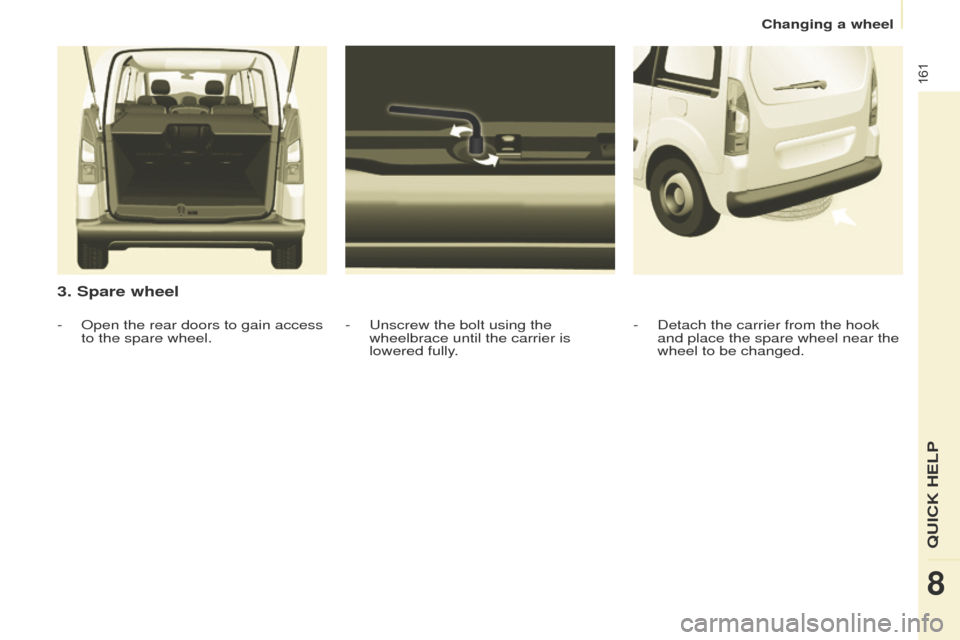
161
Partner_2_VP_en_Chap08_Aide-rapide_ed02-2014
3. Spare wheel
- unscrew the bolt using the
wheelbrace until the carrier is
lowered fully
.
-
Open the rear doors to gain access
to the spare wheel. -
Detach the carrier from the hook
and place the spare wheel near the
wheel to be changed.
Changing a wheel
QuICK HeLP
8
Page 164 of 276
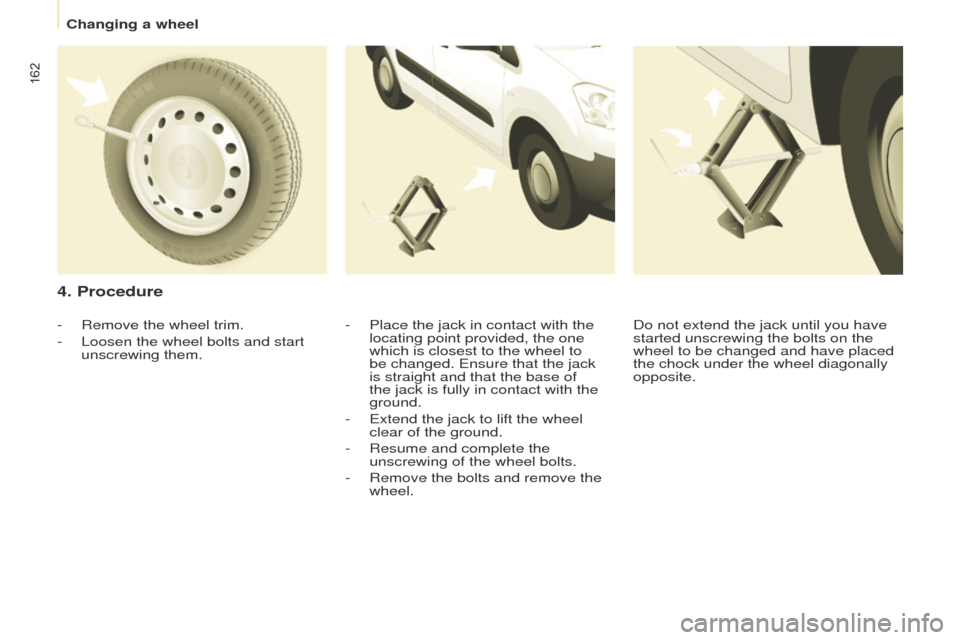
162
Partner_2_VP_en_Chap08_Aide-rapide_ed02-2014
4. Procedure
- Place the jack in contact with the
locating point provided, the one
which is closest to the wheel to
be changed. e nsure that the jack
is straight and that the base of
the jack is fully in contact with the
ground.
-
e xtend the jack to lift the wheel
clear of the ground.
-
Resume and complete the
unscrewing of the wheel bolts.
-
Remove the bolts and remove the
wheel.
-
Remove the wheel trim.
-
Loosen the wheel bolts and start
unscrewing them. Do not extend the jack until you have
started unscrewing the bolts on the
wheel to be changed and have placed
the chock under the wheel diagonally
opposite.
Changing a wheel
Page 165 of 276
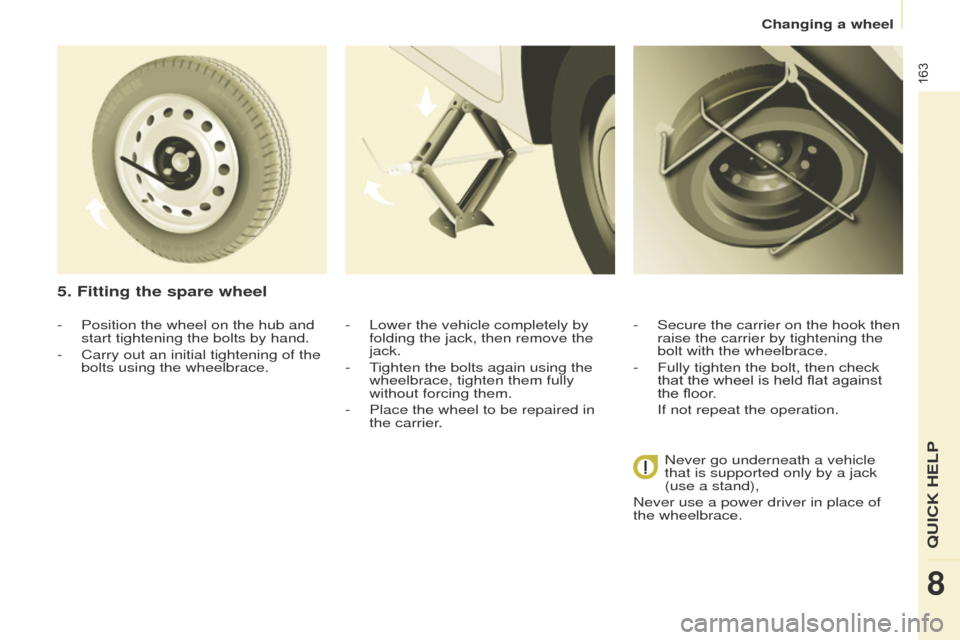
163
Partner_2_VP_en_Chap08_Aide-rapide_ed02-2014
- Position the wheel on the hub and
start tightening the bolts by hand.
-
Carry out an initial tightening of the
bolts using the wheelbrace.
5. Fitting the spare wheel
- Lower the vehicle completely by
folding the jack, then remove the
jack.
-
t
ighten the bolts again using the
wheelbrace, tighten them fully
without forcing them.
-
Place the wheel to be repaired in
the carrier
. -
Secure the carrier on the hook then
raise the carrier by tightening the
bolt with the wheelbrace.
-
Fully tighten the bolt, then check
that the wheel is held flat against
the floor
.
If not repeat the operation.Never go underneath a vehicle
that is supported only by a jack
(use a stand),
Never use a power driver in place of
the wheelbrace.
Changing a wheel
QuICK HeLP
8
Page 166 of 276
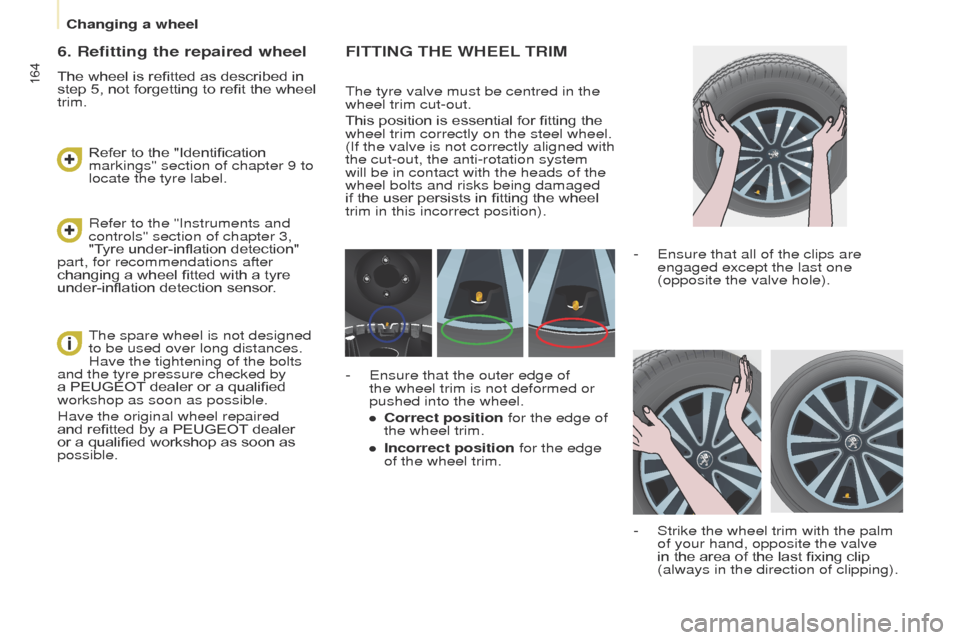
164
Partner_2_VP_en_Chap08_Aide-rapide_ed02-2014
FITTING THE WHEEL TRIM
the tyre valve must be centred in the
wheel trim cut-out.
This position is essential for fitting the
wheel trim correctly on the steel wheel.
(If
the valve is not correctly aligned with
the cut-out, the anti-rotation system
will be in contact with the heads of the
wheel bolts and risks being damaged
if the user persists in fitting the wheel
trim in this incorrect position).
-
e nsure that all of the clips are
engaged except the last one
(opposite the valve hole).
-
Strike the wheel trim with the palm
of your hand, opposite the valve
in the area of the last fixing clip
(always in the direction of clipping).
-
e nsure that the outer edge of
the wheel trim is not deformed or
pushed into the wheel.
●
Correct position
for the edge of
the wheel trim.
●
Incorrect position
for the edge
of the wheel trim.
6. Refitting the repaired wheel
The wheel is refitted as described in
step 5, not forgetting to refit the wheel
trim.
Refer to the "Instruments and
controls" section of chapter 3,
"Tyre under-inflation detection"
part, for recommendations after
changing a wheel fitted with a tyre
under-inflation detection sensor. Refer to the "Identification
markings" section of chapter 9 to
locate the tyre label.
t
he spare wheel is not designed
to be used over long distances.
Have the tightening of the bolts
and the tyre pressure checked by
a PEUGEOT dealer or a qualified
workshop as soon as possible.
Have the original wheel repaired
and refitted by a PEUGEOT dealer
or a qualified workshop as soon as
possible.
Changing a wheel
Page 167 of 276
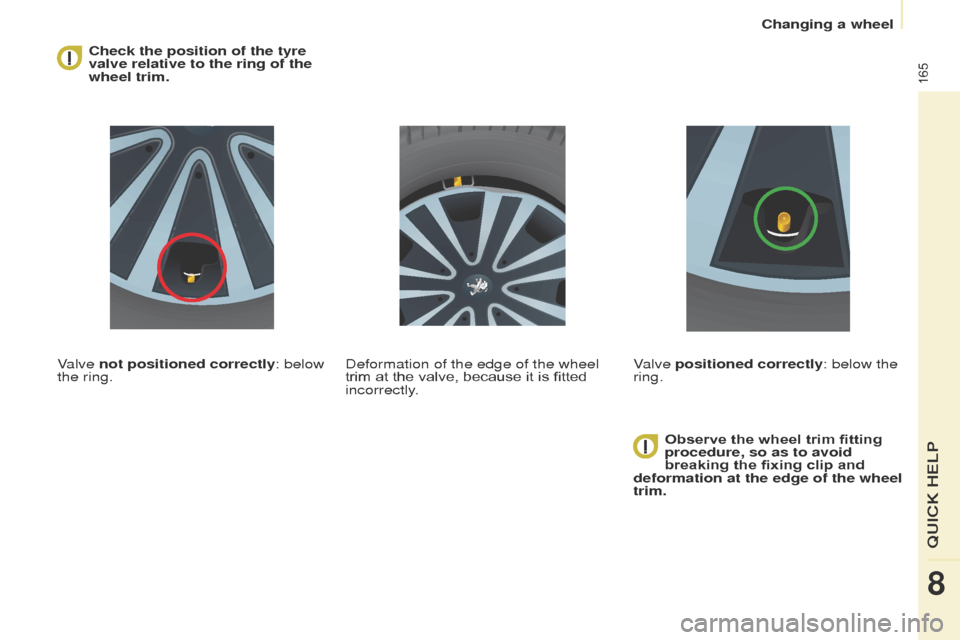
165
Partner_2_VP_en_Chap08_Aide-rapide_ed02-2014
Check the position of the tyre
valve relative to the ring of the
wheel trim.
Valve not positioned correctly: below
the ring. Observe the wheel trim fitting
procedure, so as to avoid
breaking the fixing clip and
deformation at the edge of the wheel
trim.
Deformation of the edge of the wheel
trim at the valve, because it is fitted
incorrectly.
Valve positioned correctly: below the
ring.
Changing a wheel
QuICK HeLP
8
Page 168 of 276
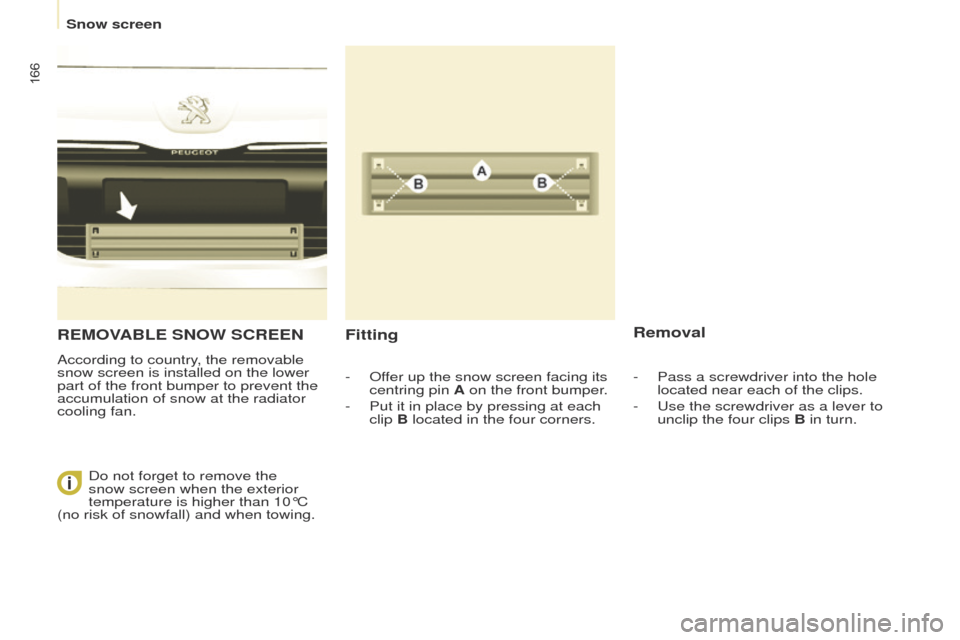
166
Partner_2_VP_en_Chap08_Aide-rapide_ed02-2014
REMOVABLE SNOW SCREEN
According to country, the removable
snow screen is installed on the lower
part of the front bumper to prevent the
accumulation of snow at the radiator
cooling fan.
FittingRemoval
- Offer up the snow screen facing its
centring pin A on the front bumper.
-
Put it in place by pressing at each
clip
B located in the four corners.
Do not forget to remove the
snow screen when the exterior
temperature is higher than 10°C
(no risk of snowfall) and when towing. -
Pass a screwdriver into the hole
located near each of the clips.
-
u se the screwdriver as a lever to
unclip the four clips B in turn.
Snow screen
Page 169 of 276
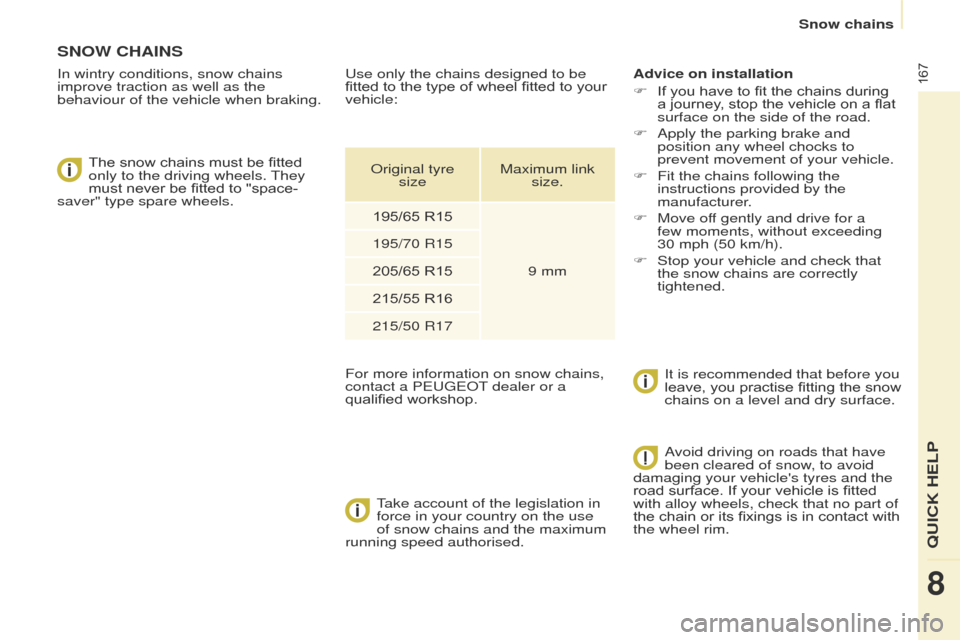
167
Partner_2_VP_en_Chap08_Aide-rapide_ed02-2014
SNOW CHAINS
In wintry conditions, snow chains
improve traction as well as the
behaviour of the vehicle when braking.The snow chains must be fitted
only to the driving wheels.
t
hey
must never be fitted to "space-
saver" type spare wheels.
take account of the legislation in
force in your country on the use
of snow chains and the maximum
running speed authorised. Advice on installation
F
If you have to fit the chains during
a journey
, stop the vehicle on a flat
surface on the side of the road.
F
Apply the parking brake and
position any wheel chocks to
prevent movement of your vehicle.
F
Fit the chains following the
instructions provided by the
manufacturer
.
F
Move of
f gently and drive for a
few moments, without exceeding
30
mph (50 km/h).
F
Stop your vehicle and check that
the snow chains are correctly
tightened.It is recommended that before you
leave, you practise fitting the snow
chains on a level and dry surface.
u se only the chains designed to be
fitted to the type of wheel fitted to your
vehicle:
For more information on snow chains,
contact a P
euge O t
dealer or a
qualified workshop. Original tyre
size Maximum link
size.
195/65 R15
9 mm
195/70 R15
205/65 R15
215/55 R16
215/50 R17
Avoid driving on roads that have
been cleared of snow, to avoid
damaging your vehicle's tyres and the
road surface. If your vehicle is fitted
with alloy wheels, check that no part of
the chain or its fixings is in contact with
the wheel rim.
Snow chains
QuICK HeLP
8
Page 170 of 276
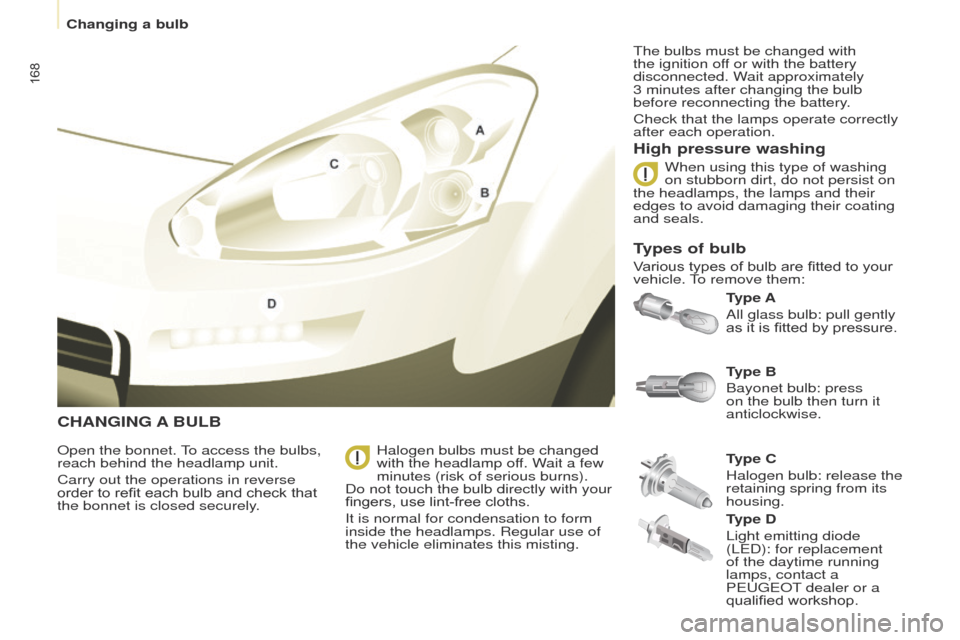
168
Partner_2_VP_en_Chap08_Aide-rapide_ed02-2014
CHANGING A BULB
Type A
All glass bulb: pull gently
as it is fitted by pressure.
High pressure washing
Open the bonnet. to access the bulbs,
reach behind the headlamp unit.
Carry out the operations in reverse
order to refit each bulb and check that
the bonnet is closed securely
. Type C
Halogen bulb: release the
retaining spring from its
housing. Type B
Bayonet bulb: press
on the bulb then turn it
anticlockwise.
Halogen bulbs must be changed
with the headlamp off. Wait a few
minutes (risk of serious burns).
Do not touch the bulb directly with your
fingers, use lint-free cloths.
It is normal for condensation to form
inside the headlamps. Regular use of
the vehicle eliminates this misting.
t
he bulbs must be changed with
the ignition off or with the battery
disconnected. Wait approximately
3 minutes after changing the bulb
before reconnecting the battery.
Check that the lamps operate correctly
after each operation.
When using this type of washing
on stubborn dirt, do not persist on
the headlamps, the lamps and their
edges to avoid damaging their coating
and seals.
Types of bulb
Various types of bulb are fitted to your
vehicle. to remove them:
T
ype D
Light emitting diode
(L
e D): for replacement
of the daytime running
lamps, contact a
P
euge O t
dealer or a
qualified workshop.
Changing a bulb